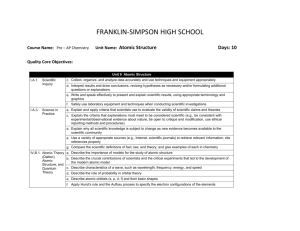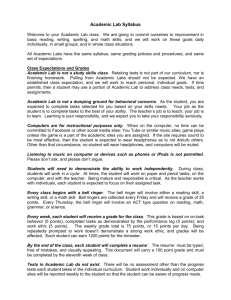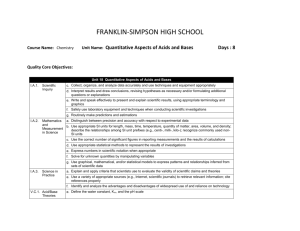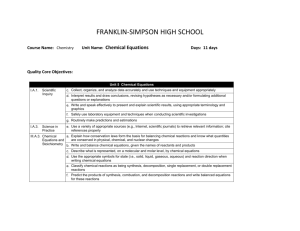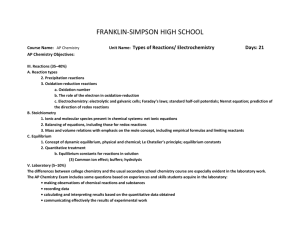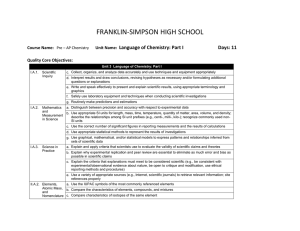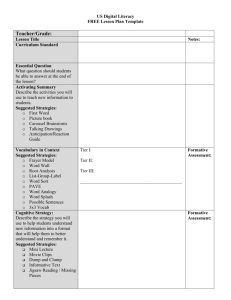Quantitative Aspects of Acids & Bases
advertisement
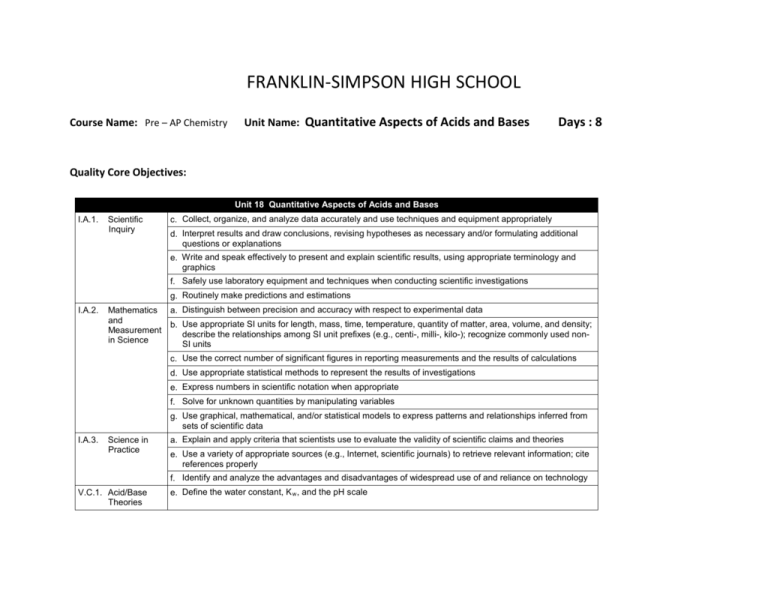
FRANKLIN-SIMPSON HIGH SCHOOL Course Name: Pre – AP Chemistry Unit Name: Quantitative Aspects of Acids and Bases Days : 8 Quality Core Objectives: Unit 18 Quantitative Aspects of Acids and Bases I.A.1. Scientific Inquiry c. Collect, organize, and analyze data accurately and use techniques and equipment appropriately d. Interpret results and draw conclusions, revising hypotheses as necessary and/or formulating additional questions or explanations e. Write and speak effectively to present and explain scientific results, using appropriate terminology and graphics f. Safely use laboratory equipment and techniques when conducting scientific investigations g. Routinely make predictions and estimations I.A.2. Mathematics a. Distinguish between precision and accuracy with respect to experimental data and b. Use appropriate SI units for length, mass, time, temperature, quantity of matter, area, volume, and density; Measurement describe the relationships among SI unit prefixes (e.g., centi-, milli-, kilo-); recognize commonly used nonin Science SI units c. Use the correct number of significant figures in reporting measurements and the results of calculations d. Use appropriate statistical methods to represent the results of investigations e. Express numbers in scientific notation when appropriate f. Solve for unknown quantities by manipulating variables g. Use graphical, mathematical, and/or statistical models to express patterns and relationships inferred from sets of scientific data I.A.3. Science in Practice a. Explain and apply criteria that scientists use to evaluate the validity of scientific claims and theories e. Use a variety of appropriate sources (e.g., Internet, scientific journals) to retrieve relevant information; cite references properly f. Identify and analyze the advantages and disadvantages of widespread use of and reliance on technology V.C.1. Acid/Base Theories e. Define the water constant, K w , and the pH scale V.C.2. Acid/Base b. Calculate hydrogen ion concentration, hydroxide ion concentration, pH, and pOH for acidic or basic solutions Constants and pH; Titration; c. Explain how the acid-base indicators work Buffers d. Define percent ionization, K a , and K b and explain how they relate to acid/base strength e. Conduct a titration experiment in order to determine the concentration of an acid or base solution f. Qualitatively understand the behavior of a buffer and explain why buffer solutions maintain pH upon dilution Purpose of the Unit: Students will be able to expand on their qualitative knowledge of acids and bases from the previous unit to a more quantitative understanding of the calculations associated with acids and bases. Students will be able to use concentration data to calculate pH and pOH as well as use Ka and Kb data to determine relative acid/ base strength. Students will achieve a basic understanding of buffers and indicators, as well as perform an acid-base titration to determine the strength of an unknown monoprotic acid. Prerequisites: Students should be able to: Identify strong and weak acids and bases Calculate concentrations of ionic species in solution Explain the similarities and differences between acids and bases Perform stoichiometric calculations Daily Lesson Guide Day 1 Lesson Content and Objectives * Kw and the pH scale * Calculating pH and pOH V.C.1.e V.C.2.b Focus Questions * What does the pH scale represent? * How can I use concentration data to calculate pH and pOH? Critical Thinking (High Yield / Literacy /LTF/etc.) * Summarizing and note taking * Evaluation/ analysis * Identifying similarities and differences * I Do – We Do – You Do * Advanced organizers Engagement * Pre-test * ACT bell ringer * Modeled notes * Math notes * Work sample problems together, alone (formative) Assessment and/or Accommodations * Evaluate pre-test * Evaluate sample problems and math notes for understanding Enrichment: Less guidance in note taking, more independence in practice, more challenging examples in formative 2 * Ka, Kb, and relationship to acid/ base strength * Acid-Base indicators V.C.2.c, d * How can I determine the strength of an acid or base? * How do indicators work and what are they used for? * Summarizing and note taking * Analysis/ Application * Identifying similarities and differences * I Do – We Do – You Do * ACT bell ringer * Modeled notes * Work sample problems together, alone (formative) * Evaluate sample problems for understanding Enrichment: Less guidance in note taking, more independence in practice, more challenging examples in formative 3 * Qualitative buffers and maintaining pH V.C.2.f * What are buffers? * Why are buffers useful? * Summarizing and note taking * Evaluation/ Analysis/ Application * Nonlinguistic representation * ACT bell ringer * Modeled notes * 3-2-1 exit slip (formative) * Article about the body’s buffer systems (circulatory system) * Evaluate exit slips for understanding * Evaluate students’ comprehension of article Enrichment: Less guidance in note taking, more independence in practice, more challenging examples in formative 4 * Titration calculations V.C.2.e 5-6 Laboratory: AcidBase titration: Determining unknown concentration with a standard I.A.1.c, d, e, f, g I.A.2.a, b, c, d, e, f, g I.A.3.a, e, f V.C.1.e V.C.2.b, c, d, e, f * Review I.A.1.c, d, e, f, g I.A.2.a, b, c, d, e, f, g I.A.3.a, e, f V.C.1.e V.C.2.b, c, d, e, f * Exam I.A.1.c, d, e, f, g I.A.2.a, b, c, d, e, f, g I.A.3.a, e, f V.C.1.e V.C.2.b, c, d, e, f 7 8 * How are titrations performed? * How can titration data be used to find unknown concentrations? * How can I use what I know to determine the concentration of an unknown acid using a standardized titrant? * Summarizing and note taking * Evaluation/ Analysis/ Application * I Do – We Do – You Do * Authenticity * Advanced organizers * ACT bell ringer * Modeled notes * Math notes * Work sample problems together, alone (formative) * Evaluate math notes and sample problems for understanding Enrichment: Less guidance in note taking, more independence in practice, more challenging examples in formative * Synthesis * Application/ Analysis * Identifying similarities and differences * Learning with others * Authenticity * Novelty and Variety * Generating and testing hypotheses * ACT bell ringer * Conduct lab according to procedures provided (summative) * Evaluate lab report Enrichment: Student development of lab procedures with less guidance * What can I do to be better prepared for the exam? * Use clickers to test students’ knowledge and clarify and misconceptions before the exam with immediate feedback. * ACT bell ringer * Use clickers to review with exam like questions (summative) * Students participate in review Enrichment: Less time to solve problems and limited use of aides * Can I demonstrate my knowledge on the exam? * Evaluation * Analysis * Application * Synthesis * ACT bell ringer * Students take exam (summative) * Evaluate exam Enrichment: No use of supports with exemption of periodic table, periodic table only has element symbols, not names
